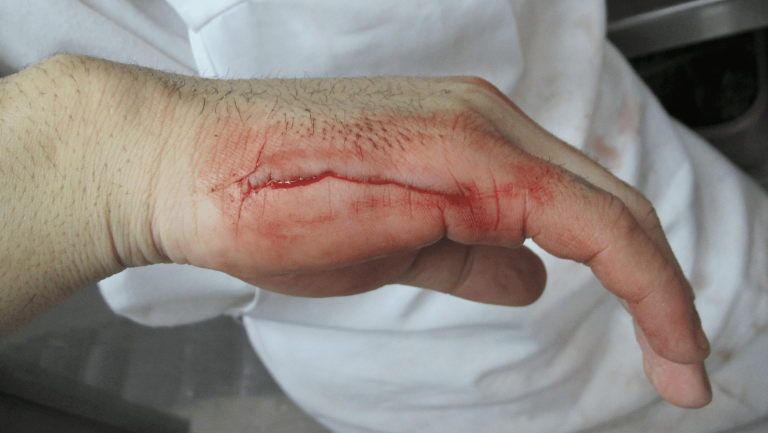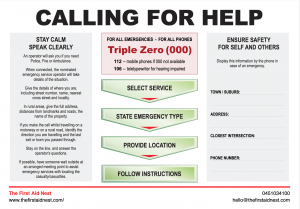10 Basic First Aid Procedures In The Workplace

Emergency situations can happen in your workplace at any time.
In this post we will cover the 10 basic first aid procedures in the workplace that all employees should know, to keep you and your colleagues safe at work and at home.
Stroke
Recognition of a stroke is as easy as F.A.S.T.
- Face – has their face dropped one side?
- Arms – Can they raise both arms up?
- Speech – Do they understand you? Do they have slurred speech?
- Time – Quick response is critical. Call emergency services ASAP
There are other signs of a stroke but these are the most common and important.
The longer a stroke goes unrecognised, the more chance of irreversible brain damage. There are two types of stroke, a clot or a bleed.
First aid while waiting for the ambulance:
- Lay the person down in the recovery position
- Loosed clothes
- Support any limbs with weakness
- No food or drink
- If they stop breathing, start CPR
Bleeding
Bleeding can be caused by minor cuts and scrapes or a major wound with haemorrhage or amputation. Both obviously treated very differently. A minor cut or scrape can simply be cleaned with water or saline and a clean or sterile cloth. A regular band aid or bandage can be used with gauze. (first aid kit blog)
See a Dr if you can’t clean the wound properly. Monitor the wound for any further pain, heat or discharge, as this may mean the wound is infected.
If someone has a major bleed, take the following steps:
- Check for danger, source gloves (if possible) and call an ambulance
- Lay the person down and raise any injured limb above the heart
- Apply pressure to stop the bleeding
- If the wound is not pumping blood, attempt to cover firmly with a bandage and gauze
- If there is an object in the wound, leave this alone but apply pressure around the object.
- Do not use a tourniquet
- If the person stops breathing, start CPR
Nosebleed
A common first aid situation, even in adults! We may have often seen people being told to tilt their head back when they have a nosebleed, but this is now incorrect.
First aid for a nosebleed:
- Sit upright and tilt head forward
- Squeeze nostrils shut and hold for 5-10 minutes to stop the bleeding
- If the bleed continues for 20 minutes or longer, seek medical attention
- Avoid blowing the nose for the rest of the day
Sprain or strain
A simple slip or a trip up a step can cause an excruciatingly painful injury. A sprained ankle can be more painful than a broken bone and a strain or torn muscle is not far behind on the pain scale.
There are some simple first aid steps to take before seeking medical attention:
- Stop the casualty moving the affected area
- Elevate and apply ice
- Compress the area to reduce swelling
- Some oral medicines can help with pain and swelling
Burns
Burns can be extremely painful and can tend to not heal very well if they are not treated properly.
- If someone sustains a burn (that is not a chemical burn), run it under cool running water for 20 minutes.
- Cover with cling film or a non-stick dressing
- Do not apply lotions or creams
- If larger than 3cm, seek medical advice immediately
- If the burn is on hands, feet, genitals or face, seek medical advice immediately
- If the person is showing signs of shock, call an ambulance
Broken bones
Broken bones are a common injury, but vary greatly in severity.
Some can be corrected by supportive treatment of a bandage, sling or a boot, but others may require surgery with pins and plates.
Broken bones present with the following symptoms:
- Pain at injury site
- Deformity or limb
- Bruising and/or swelling
- Not able to use the limb
First aid for a casualty with a suspected fracture:
- Keep the person still
- If able to support the fracture, place a pillow under the arm or leg to slightly raise
- Support a broken arm or collarbone in a sling
- Apply a cold pack for pain
- The casualty should not eat or drink until they have been seen by a Dr
- Safely mobilise the casualty to hospital
- Call an ambulance if you can’t move the casualty

First aid training also covers the following scenarios in detail:
CPR
CPR is an essential skill and often mandatory in the workplace. It is short for cardiopulmonary resuscitation.
CPR should be started as soon as possible to help achieve a good outcome. The aim of CPR is to keep the oxygenated blood pumping around the major organs. We are not expecting to fix the problem with CPR, just sustain the casualty.
Steps of CPR:
- Casualty should be laying on their back on a hard surface
- Place the heel of your hand on lower half of the breastbone in-between the nipples. Place second hand on top interlocking fingers
- Position yourself up on your knees
- Push down firmly 30 times, with a short sharp compression approx. 1/3 of the depth of the chest at a rate of 2 per second
- After 30 compressions, give 2 rescue breaths if you are trained and able to.
- Tilt the casualties head back a little into the sniffing position
- Pinch the nose
- Place your mouth over the patient’s mouth creating a good seal
- Blow until you see chest rise, repeat for total of two breaths
- Commence 30 compressions again
- Repeat until help arrives or the casualty revives
Anaphylaxis
Food allergens can be hidden in many different foods and products nowadays.
If you work in a place with more than 5 people, one of them is likely to have food allergies and possibly carry an Epipen. Although people with food allergies are usually quite vigilant with what they put in their mouth, sometimes ingredients are hidden and this is where the danger lies. Cakes and other baked goods can hide a multitude of sins, most you won’t even taste.
Recognising the symptoms of an allergic reaction could save a life. Allergic reactions can take hold very quickly and turn into anaphylaxis (severe allergic reaction) in the blink of an eye. Giving an Epipen is quite simple, but sometimes panic can make the situation worse.
Symptoms of mild to moderate allergic reaction are:
- Swelling of lips, face, eyes
- Tingling mouth
- Hives or welts
- Abdominal pain, vomiting
Symptoms of severe allergic reaction (anaphylaxis)
- Difficult or noisy breathing
- Swelling of tongue
- Swelling or tightness in throat
- Wheeze or persistent cough
- Difficulty talking or hoarse voice
- Persistent dizziness or collapse
- Pale and floppy (young children)

Choking
Choking has to be one of the most frightening situations, both for the victim and any bystanders. There are a few tell tile signs to identify if someone is truly choking.
- Clutching of throat
- Coughing, gagging or wheezing
- Can’t talk
- Agitated
- Lose consciousness
- Blue lips, face, fingernails
Most first aid courses will teach you exactly how to help someone who is choking.
The steps of choking first aid are:
- Keep person calm
- Encourage to cough
- If they can’t cough, call an ambulance
- Lean them forward and give them 5 back blows between the shoulder blades
- Check the mouth between each back blow to see if the blockage has cleared
- If no change after 5 back blows, commence 5 chest thrusts
- Place casualty against a hard back (chair or floor)
- Place heel of hand in the centre of the chest and push firmly inward and upward
- Keep checking to see if blockage clears
- If no change after 5 chest thrusts, go back to 5 back blows and continue to alternate back blows and chest thrusts until help arrives or if they stop breathing, you need to start CPR
Head Injury
Head injuries can be scary because the worst kind of injury can be completely hidden and may not show signs for hours or sometimes days.
There are some specific symptoms that need urgent medical attention, such as:
- Vomiting more than once
- Slurred speech
- Impaired hearing or sight
- Confusion or agitation
- Drowsy or unconscious
- Uneven pupils
- Dizziness or loss or balance
- Memory loss
- Bleeding or discharge from ear or nose
First Aid Courses
The First Aid Nest specialise in group workplace first aid Australia wide.
Choose from various different delivery options from 80% online to 100% full face to face. It’s entirely up to you and how your workforce would best learn.
Contact us today or simply book via our website and we will be in touch within 24 hours to lock in a date for you. We can’t wait to meet you!
